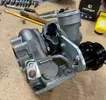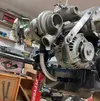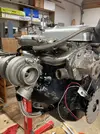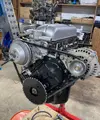There is more to life with TurboRenault.co.uk
You are using an out of date browser. It may not display this or other websites correctly.
You should upgrade or use an alternative browser.
You should upgrade or use an alternative browser.
Steve Swan
Well-Known Member
I would say you would be ok to use the tappings at either end as they are both going into the main gallery. The fittings look like jic or dash fittings for me. Too many slang terms for pipe fittings in the world....
I use the other gallery port for an oil prssure gauge. I should add an oil temp sensor/gauge too.That fitting should be fine as assume full flow. I have an oil temp sensor in mine currently.
I now have a rebuilt turbocharger, balanced and ready to go! I decided to use an adjustable wastegate actuator. I'll start at 5psi so I won't blow up the motor right away (I hope.) Then go to 7 and 10 psi as I work out the ignition map. I had to be creative with the actuator shaft due to the orientation of the compressor housing I need.

The turbo is a tight fit. The actuator just misses the alternator.

I also have the oil drain line worked out. I used braided hose and AN fittings for a tidier look. It's overkill, I know,

The oil feed line is next.

The turbo is a tight fit. The actuator just misses the alternator.

I also have the oil drain line worked out. I used braided hose and AN fittings for a tidier look. It's overkill, I know,

The oil feed line is next.
Steve Swan
Well-Known Member
Someone on this very forum has posted up the map from the old AEI renix unit. Basically it has a map which is used when there is no vacuum in the manifold (positive pressure) When the throttle is closed or just open (cruising conditions) and there is vacuum in the manifold it switches to another map, which is the same as the first map, but plus 20 degrees advance.
This is because the engines requirement for IGN advance is very different depending on what it is doing. It probably only wants 24 degrees or so when the throttle is on the floor, but when you lift to cruise, you in effect have a low compression engine which will take a silly amount of advance, as it has no BMEP. this also has the effect of minimising any energy in the exhaust gas which puts the turbo into cruise mode also. giving reasonable fuel economy.
An atmo cruising at 4000 rpm is probably going to have about 26 degrees of advance on and if the vac unit is connected it will be adding around 6-9 degrees onto that. When the throttle is opened the vac unit drops the timing back so it doesn't detonate as the BMEP rises.
Turbo engine is no different, but will take a much larger swing as it is nowhere near optimised off boost. Cruising at 4000 rpm it will probably run 50 degrees advance as it is already a low comp motor, plus the throttle is shut meaning its running much less than 7:1 so you need to light it very early for the slow burn time.
This is the most crucial part of any engines set up and is dependant on the actual running conditions at the time. most people get lost in the ultimate power game on turbo engines, but getting the low boost/ cruising map right gives a much nicer engine to live with in reality. Getting the transition between the two correct results in less wreckage.........
This is because the engines requirement for IGN advance is very different depending on what it is doing. It probably only wants 24 degrees or so when the throttle is on the floor, but when you lift to cruise, you in effect have a low compression engine which will take a silly amount of advance, as it has no BMEP. this also has the effect of minimising any energy in the exhaust gas which puts the turbo into cruise mode also. giving reasonable fuel economy.
An atmo cruising at 4000 rpm is probably going to have about 26 degrees of advance on and if the vac unit is connected it will be adding around 6-9 degrees onto that. When the throttle is opened the vac unit drops the timing back so it doesn't detonate as the BMEP rises.
Turbo engine is no different, but will take a much larger swing as it is nowhere near optimised off boost. Cruising at 4000 rpm it will probably run 50 degrees advance as it is already a low comp motor, plus the throttle is shut meaning its running much less than 7:1 so you need to light it very early for the slow burn time.
This is the most crucial part of any engines set up and is dependant on the actual running conditions at the time. most people get lost in the ultimate power game on turbo engines, but getting the low boost/ cruising map right gives a much nicer engine to live with in reality. Getting the transition between the two correct results in less wreckage.........
Steve Swan
Well-Known Member
No. It's not that simple. Years ago we tried to run one on a dizzy which didn't work it needs to be able to switch in a heartbeat. I'll try to find the thread with the map.

 turborenault.co.uk
turborenault.co.uk
5 GT Turbo - C1J Ignition Map
Would be interesting to see what ignition advance maps are people with EFI setups running on std engines (CR ~8:1) with std or more aggressive cams. For example this is supposed to be a std ignition map of a RE209 AEI.
Ok, I misunderstood your explanation. I'm planning to use microsquirt or megajolt with a coilpack and eliminate the distributor completely.
I can use the 5GT Turbo map as a starting point. My c3j CR is 9:1 so a liitle more retard in the map will be required as I increase boost pressure.
I can use the 5GT Turbo map as a starting point. My c3j CR is 9:1 so a liitle more retard in the map will be required as I increase boost pressure.
Last edited:
My bellhousing is too small for a MK2 flywheel, so I'll have to put a trigger wheel on the crank (more fun). And thanks for the heads up on egt's.Not sure what size flywheel your using, but probably worth going for something with 60-2 for wasted spark, to save the arse on of trigger wheel on the crank.
High comp works well on these. Keep an eye on egt's.
More progress on my 8 Turbo. I've finished the oil supply line. I'm tapping into the gallery at the opening beside the oil filter.

And a 36-1 trigger wheel mounted on the crank pulley. The hall effect pickup is bolted to the timing cover.

The other end of the oil feed line for the turbo.

Cut the dizzy off since I'll be using Microsquirt/wasted spark. And yes, I remembered to put the oil pump drive gear in place.

I'm beginning to appreciate how much work Steve S did on Paul E's car!

And a 36-1 trigger wheel mounted on the crank pulley. The hall effect pickup is bolted to the timing cover.

The other end of the oil feed line for the turbo.

Cut the dizzy off since I'll be using Microsquirt/wasted spark. And yes, I remembered to put the oil pump drive gear in place.

I'm beginning to appreciate how much work Steve S did on Paul E's car!
Moved the alternator to the other side of the motor away from the turbo. I had to replace the standard R8 water pump housing with one from an R12 1.4 to make room for the drive belt. I fabricated a new alternator bracket since I couldn't find an R12 bracket.

Now for the fuel pump and pressure regulator. Does the stock setup use a constant pressure pump and a regulator that changes pressure with boost? If so, I'll need to add a fuel return to the stock R8 tank, maybe in the fuel filler tube. What pressure do I need from the pump to use this approach? And what is the fuel pressure from the regulator as a function of boost?
I just did some research on the fuel setup and answered most of my questions. The fuel pressure at the carb should be 4 psi + boost (thanks @Brigsy). I'll be using an external pump. So if my max boost is 10 psi I'll need a pump that delivers 14 psi, right? Or should a go with a little more pressure, say 16-18 psi?
I'm slowly learning that almost every question I have has already been answered on this forum!

Now for the fuel pump and pressure regulator. Does the stock setup use a constant pressure pump and a regulator that changes pressure with boost? If so, I'll need to add a fuel return to the stock R8 tank, maybe in the fuel filler tube. What pressure do I need from the pump to use this approach? And what is the fuel pressure from the regulator as a function of boost?
I just did some research on the fuel setup and answered most of my questions. The fuel pressure at the carb should be 4 psi + boost (thanks @Brigsy). I'll be using an external pump. So if my max boost is 10 psi I'll need a pump that delivers 14 psi, right? Or should a go with a little more pressure, say 16-18 psi?
I'm slowly learning that almost every question I have has already been answered on this forum!
Which is the beauty of forums instead of facebook.I'm slowly learning that almost every question I have has already been answered on this forum!
Really enjoy reading others updates as well. Great lunchtime entertainment.
Steve Swan
Well-Known Member
All correct
Is the gtt pump an in-tank one? I need an external pump for my setup.From memory stock gtt pump is 130lph. Use a gtt pump.
Similar threads
- Replies
- 2
- Views
- 77
- Replies
- 1
- Views
- 214
- Replies
- 4
- Views
- 342
- Question
5 GT Turbo
MK1 GT Turbo Gordini HELP
- Replies
- 2
- Views
- 77
